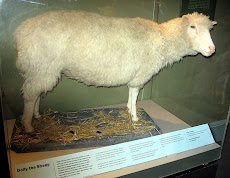If Neanderthals ever walk the earth again, the primordial ooze from which they will rise is an emulsion of oil, water, and DNA capture beads engineered in the laboratory of 454 Life Sciences in Branford, Connecticut. Over the past 4 years those beads have been gathering tiny fragments of DNA from samples of dissolved organic materials, including pieces of Neanderthal bone. Genetic sequences have given paleoanthropologists a new line of evidence for testing ideas about the biology of our closest extinct relative.
The first studies of Neanderthal DNA focused on the genetic sequences of mitochondria, the microscopic organelles that convert food to energy within cells. In 2005, however, 454 began a collaborative project with the Max Planck Institute in Leipzig, Germany, to sequence the full genetic code of a Neanderthal woman who died in Croatia's Vindija cave 30,000 years ago. As the Neanderthal genome is painstakingly sequenced, the archaeologists and biologists who study it will be faced with an opportunity that seemed like science fiction just 10 years ago. They will be able to look at the genetic blueprint of humankind's nearest relative and understand its biology as intimately as our own.
In addition to giving scientists the ability to answer questions about Neanderthals' relationship to our own species--did we interbreed, are we separate species, who was smarter--the Neanderthal genome may be useful in researching medical treatments. Newly developed techniques could make cloning Neanderthal cells or body parts a reality within a few years. The ability to use the genes of extinct hominins is going to force the field of paleoanthropology into some unfamiliar ethical territory. There are still technical obstacles, but soon it could be possible to use that long-extinct genome to safely create a healthy, living Neanderthal clone. Should it be done?
At the 454 Life Sciences offices, Gerald Irzyk, Jason Affourtit, and Thomas Jarvie explain the process they use to read the chemicals that made up Neanderthal DNA and the genes that determined a large part of their biology. DNA has a shape, called a double helix, that makes it look like a twisted ladder. Each rung on the ladder is called a base-pair. The rungs are made up of a pair of chemicals called nucleotides--adenine, thymine, cytosine, and guanine, which are usually referred to by their first initials. The sequence of the nucleotides in the DNA determines what genes an organism has and how they function.
Although most of the Neanderthal genome sequencing is now being done by the San Diego-based company Illumina, the Max Planck Institute initially chose 454 because it had come up with a way to read hundreds of thousands of DNA sequences at a time. Genome-sequencing technology is advancing at a rate comparable to computer processing power. "Six years ago if you wanted to sequence E. coli [a species of bacteria], which is about 4 million base-pairs in length, it would have taken one or maybe two million dollars, and it would have taken a year and 150 people," says Jarvie. "Nowadays, one person can do it in two days and it would cost a few hundred dollars."
Putting the fragments themselves in order can be a little tricky. "At first glance, it's just this completely random assemblage of As, Ts, Cs, and Gs," says Irzyk. "But it turns out there are patterns and motifs, and sometimes these are very specific to a group of organisms." For the Neanderthal sample, the human and chimpanzee genomes were used as references for checking the sequence.
Working with ancient DNA can be much more problematic than sequencing genetic material from living species. Within hours of death, cells begin to break down in a process called apoptosis. The dying cells release enzymes that chop up DNA into tiny pieces. In a human cell, this means that the entire three-billion-base-pair genome is reduced to fragments a few hundred base-pairs long or shorter. The DNA also goes through chemical changes that alter the nucleotides as it ages--C changes into T, and G turns into A--which can cause the gene sequence to be interpreted incorrectly. In the case of the Neanderthal sample, somewhere between 90 and 99 percent of the DNA came from bacteria and other contaminants that had found their way into the bone as it sat in the ground and in storage. The contaminant DNA has to be identified and eliminated. Given the similarity between Neanderthal and modern human DNA, this can be especially difficult when the contamination comes from the people who excavated or analyzed the bone.
Monday, May 3, 2010
Subscribe to:
Post Comments (Atom)


No comments:
Post a Comment